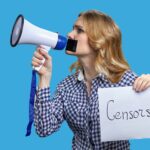Imagine logging onto your favorite social media platform, excited to share a thought or catch up on the latest news. But then, your post mysteriously disappears, or you scroll through a sea of flagged content. Have you ever wondered: where’s the line between protecting free speech and keeping our digital spaces safe? This is the dilemma social media companies wrestle with every single day, and it’s a tough one. Social media censorship raises important questions about how we navigate the intersection of free expression and online harm prevention.
We all know that social media is the new public square—a place where ideas are shared, debated, and sometimes even shouted. But in a world where a single post can reach millions in seconds, what happens when that post spreads misinformation or incites violence? The stakes are high, and the pressure on platforms like Facebook, X (formerly Twitter), and Instagram is immense. They’re tasked with balancing free speech on social media with the responsibility to stop harm from spreading.
The Ethical Tightrope of Content Moderation
Content moderation isn’t a glamorous topic, but it’s one of the most critical debates of our digital age. It’s the silent process that determines what we see—and more importantly, what we don’t. When you post something online, it doesn’t just exist in a vacuum. It gets analyzed, filtered, and sometimes flagged by complex algorithms or human moderators. This is where things get tricky.
How do platforms decide what to censor? And why do they seem to always upset someone, no matter what decision they make?
Here’s the truth: social media censorship isn’t just about playing referee. It’s about walking through a minefield of ethical decisions. One person’s free expression is another person’s hate speech. What one community sees as “necessary debate,” another sees as “harmful disinformation.” It’s a balancing act, and it can feel impossible to get right.
Consider this: a platform that allows everything—no holds barred—runs the risk of becoming a breeding ground for harmful content, like extremism or abuse. But, on the other hand, too much content moderation could stifle the very thing that makes social media so revolutionary: the free and open exchange of ideas.
Who Gets to Decide What’s Harmful?
So, who gets to make these calls? Is it the platforms themselves, governments, or users? Right now, it’s mostly up to the platforms, and that’s where things get dicey.
Algorithms, for instance, play a huge role. But they aren’t perfect. They might accidentally flag an innocent meme while letting a dangerous post slide through. It’s not just machines making these decisions, though—human moderators are also involved. And when humans are involved, biases and personal judgment can creep in.
To add another layer to the problem, social media censorship has turned platforms into political battlegrounds. Politicians and interest groups often pressure these platforms to either tighten up or loosen their content moderation policies, depending on their agenda. You see this especially in cases involving misinformation, hate speech, or political content.
For example, during elections or public health crises, platforms are under intense scrutiny to prevent the spread of false or dangerous information. But there’s a fine line between cracking down on false claims and censoring legitimate debate.
Free Speech or Harm Prevention: Is There a Middle Ground?
This is where the crux of the issue lies: how do we protect free speech on social media while also preventing harm?
On one hand, freedom of expression is a fundamental right—people should have the ability to voice their opinions, however controversial or unpopular. That’s what drives social change. Imagine if civil rights activists or whistleblowers were censored in the past. History would look very different.
But on the other hand, freedom has limits, especially when it causes real-world harm. Social media censorship can help control hate speech, prevent harassment, and curb the spread of dangerous misinformation. We’ve all seen how a single conspiracy theory can spread across the globe in hours, leaving chaos and real-world consequences in its wake. Think of how misinformation about vaccines or elections can erode trust in institutions or put lives at risk. This is where ethical moderation and online harm prevention play critical roles.
Innovation in Ethical Moderation: Rethinking the Way Forward
Platforms are now experimenting with different ways to handle this challenge. Some have introduced more nuanced systems for content moderation, focusing on context rather than blanket bans. Facebook, for example, has set up an independent oversight board, often dubbed its “Supreme Court,” to make difficult content decisions. Platforms are also investing in more transparent algorithms and clearer user guidelines to make social media censorship more predictable.
But one thing is clear: we can’t just leave this to the platforms. It’s too big a job for any single entity. Governments, tech companies, and users themselves all need to be part of the conversation. Public trust is at stake, and the internet isn’t going to get any smaller or less important.
Why You Should Care?
Here’s why this matters to you. Every time you post, tweet, or comment online, you’re participating in this debate. Your voice is part of the ongoing conversation about how we shape the digital spaces we all share. Should we prioritize free speech on social media at all costs, or should we work harder to prevent harm? These aren’t abstract issues—they affect real lives and communities.
Next time you see a post flagged or a trending hashtag disappear, don’t just get frustrated—think about why. Ask yourself: what kind of online world do we want to live in? Because the truth is, we’re all helping to build it.
Social media censorship isn’t going away anytime soon. But with thoughtful debate and innovative solutions, we can create a future where our online spaces are both free and safe—a place where ideas thrive, but harm is kept in check. Now, more than ever, we need to get this balance right.
Are we there yet? Not quite. But the conversation is just beginning, and your voice matters.
Click here to read our latest article Children and Social Media




